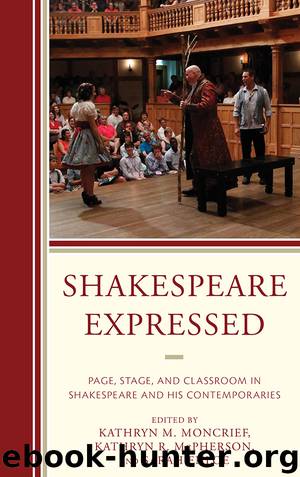Shakespeare Expressed by unknow

Author:unknow
Language: eng
Format: epub
ISBN: 9781611475609
Publisher: Fairleigh Dickinson University Press
Published: 2013-01-15T07:00:00+00:00
Chapter Fifteen
“Remembrances of Yours”
Properties, Performance, and Memory in Shakespeare’s Hamlet 3.1
Kathryn M. Moncrief
Shakespeare’s Hamlet, Prince of Denmark is a play obsessed with memory. From King Claudius’s assertion that though the memory of his brother’s death “be green” (1.2.2)1 and his listeners ought to “think on him / Together with remembrance of ourselves” (1.2.7), to Hamlet’s tortured “Must I remember” (1.2.143), to Polonius’s desire to impart “these few precepts in thy memory” (1.3.58) before his son departs, to Laertes’s insistence that his sister “remember well / What I have said to you” (1.3.84–85), to the ghost’s injunction to his son that he must “remember me” (1.5.91) and his reminder “Do not forget!” (3.4.110)—and there are other examples—remembering, and the consequences of forgetting, echo and reverberate throughout the play.
The play is also keenly conscious of the connection between material objects and memory. As Peter Stallybrass, Roger Cartier, J. Franklin Mowery, and Heather Wolfe have convincingly shown, books are prominent in Hamlet and are intricately connected to memory; they argue, “perhaps the most important book in the play, both figuratively and literally, is that of memory” (379).2 Another prominent material object, Ophelia’s rosemary “for remembrance” (4.5.175), is an obvious object of memory, as is Yorick’s skull, which functions as a potent and present memento mori. The image of Hamlet holding the skull of “poor Yorick” (5.1.184), remembering him as a “fellow of infinite jest” (5.1.185) who “bore me on his back a thousand times” (5.1.186), is one of the play’s most persistent and easily identifiable moments.
This essay focuses on Hamlet’s act 3, scene 1 (or 2.2 in Q1)—the so-called nunnery scene—in an effort to understand the significance of Ophelia’s line, “My Lord, I have remembrances of yours / That I have longed long to redeliver. I pray you receive them” (3.1.92–94) and Hamlet’s response, “No, not I, / I never gave you aught” (3.1.94–95), as well as the implications for theatrical performance. Though the lines suggest that she gives (or attempts to give) him something, what, exactly, Ophelia gives to Hamlet when, observed by both her father and the king, she is made to interact with him is never made clear. Other properties used in the play, including books, writing tables, skulls, swords, flowers, and a cup and pearl, are either specified in stage directions or are clear in dialogue; that another important object (particularly one specifically associated with memory) remains so vague is surprising.
There are many possible options for “remembrances.” Ann Thompson and Neil Taylor, in the Arden edition of the play, gloss “remembrances” as “gifts, momentoes, love-tokens,”3 and Pamela S. Hammonds defines “love tokens” as “items exchanged to show affection, love, or desire between romantic lovers, family members, or friends or to express religious devotion”4 and notes how frequently love poems “refer to or depict very tangible material items, such as rings, bracelets, necklaces, flowers, lace, body parts and children.”5 Understanding the remembrances as gifts works to establish the relationship between Hamlet and Ophelia. As Karen Newman has observed, drawing on
Download
This site does not store any files on its server. We only index and link to content provided by other sites. Please contact the content providers to delete copyright contents if any and email us, we'll remove relevant links or contents immediately.
The Goal (Off-Campus #4) by Elle Kennedy(13543)
Kathy Andrews Collection by Kathy Andrews(11730)
Diary of a Player by Brad Paisley(7487)
What Does This Button Do? by Bruce Dickinson(6135)
Assassin’s Fate by Robin Hobb(6131)
Big Little Lies by Liane Moriarty(5703)
Altered Sensations by David Pantalony(5046)
Pale Blue Dot by Carl Sagan(4913)
Sticky Fingers by Joe Hagan(4103)
The Death of the Heart by Elizabeth Bowen(3552)
The Heroin Diaries by Nikki Sixx(3496)
Beneath These Shadows by Meghan March(3263)
Confessions of a Video Vixen by Karrine Steffans(3246)
How Music Works by David Byrne(3187)
The Help by Kathryn Stockett(3085)
Jam by Jam (epub)(3025)
Harry Potter 4 - Harry Potter and The Goblet of Fire by J.K.Rowling(2990)
Strange Fascination: David Bowie: The Definitive Story by David Buckley(2801)
Petty: The Biography by Warren Zanes(2697)
